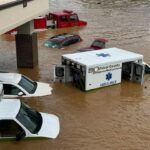
Problem: Chemical Spill
Scope: Local, Regional
Impact: Minor, Major (Depending on severity)
Dangers (not limited to): Personal Injury/Death, Air Quality, Skin and Eye Reactions
Preps (not limited to): Plan, Emergency Kit
Chemical spills can happen anywhere, anytime. Whether it is a result of an accident at a chemical plant or a truck or train carrying hazardous chemicals getting into a crash, chemical spills can be catastrophic for the people and the environment around it. In such situations, knowing how to prepare and respond to a chemical spill can help minimize the damage and potentially save lives. In this article, we will discuss some steps you can take to prepare for and respond to a chemical spill.
Preparing for a Chemical Spill
- Identify Potential Hazards: The first step to prepare for a chemical spill is to identify the potential hazards in your area. If you live near a chemical plant or work with hazardous chemicals, you are at a higher risk of exposure to a chemical spill. Knowing the types of chemicals that are used in your workplace or are present in your community can help you prepare for a chemical spill.
- Create an Emergency Plan: Once you have identified potential hazards, it is essential to create an emergency plan. The plan should include evacuation routes, designated meeting places, and emergency contacts. Everyone in your household or workplace should be aware of the emergency plan, and it should be practiced regularly.
- Create a Chemical Spill Kit: A chemical spill kit should include essential items that can help you respond to a chemical spill. The kit should include personal protective equipment, such as gloves, goggles, and a respirator, as well as absorbent materials, such as sand or kitty litter, to clean up the spill.
- Stay Informed: Stay informed about potential chemical spills in your area by signing up for emergency alerts and monitoring local news and weather reports. This information can help you take appropriate action in case of an emergency.
Responding to a Chemical Spill
- Evacuate: Evacuate the area: If possible, move to a safe area upwind of the spill. If you are unable to evacuate, shelter in place by closing windows and doors and turning off all air conditioning and heating systems.
- Call for Help: Once you are in a safe location, call emergency services and report the chemical spill. Provide as much information as possible, such as the type of chemical involved and the location of the spill.
- Follow Instructions: If you receive instructions from emergency responders or local authorities, follow them carefully. They may instruct you to shelter in place or take other actions to protect yourself.
- Avoid Contamination: If you come into contact with a chemical spill, remove contaminated clothing immediately and seek medical attention. If you are helping with the cleanup, wear personal protective equipment and follow safe cleanup procedures.
- Stay informed: Stay up to date on the latest information about the chemical spill and any health risks associated with it.

Chemical Spill Emergency Kit
An emergency preparedness kit for a chemical spill should include the following items:
- Respiratory protection: The kit should include a respirator mask that can filter out harmful chemicals. Make sure the mask is properly fitted and tested before using it.
- Chemical-resistant clothing: Include a set of clothing made from materials that are resistant to chemical exposure, such as neoprene or PVC. This includes gloves, boots, and a full-body suit.
- First aid kit: In case of any injuries or exposure, a well-stocked first aid kit with sterile bandages, eye wash, and burn treatment is essential.
- Portable water and food: In case you need to evacuate, pack a supply of food and water for at least three days.
- Flashlight and extra batteries: Make sure you have a reliable light source that can help you navigate through low visibility conditions.
- Personal hygiene items: Include items such as soap, towels, and toilet paper to maintain good hygiene.
- Duct tape: Duct Tape can be used to seal off doors and windows, preventing chemical exposure from seeping into your shelter.
- Emergency radio: A battery-powered or hand-cranked radio can keep you updated on the latest news and emergency instructions.
- Emergency contact information: Keep a list of important phone numbers, including emergency services, hospitals, and poison control centers.
- Maps and escape routes: Have a map of the area and identify possible escape routes in case of an evacuation.
It’s important to note that the specific items in an emergency preparedness kit for a chemical spill may vary depending on the type of chemicals involved and the extent of the spill. Stay informed of any updates or alerts from local authorities and follow their instructions carefully.
Conclusion
Chemical spills can be dangerous and potentially life-threatening. However, by preparing for a chemical spill and knowing how to respond, you can minimize the damage and protect yourself and those around you. Remember to stay informed, create an emergency plan, and have a chemical spill kit on hand. If a chemical spill does occur, evacuate the area, call for help, follow instructions, and avoid contamination. With proper preparation and response, you can stay safe in the event of a chemical spill.
It is our mission to educate, equip, and empower everyday ordinary civilians to understand, prepare for, and survive any emergency they face. We cannot rely on the government to take care of us. We must take it upon ourselves to provide for and protect ourselves and our families.
Note: I am an affiliate with Amazon and may receive a commission from products purchased from Amazon. This helps me continue to put out emergency preparedness information for you.










